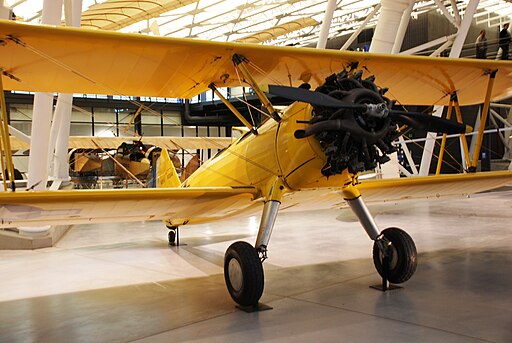The skies of the 20th century were painted with the bold silhouettes of various aircraft, each with its own tale, weaving the fabric of our global history. Among these, the Stearman Bi-plane rises – not as the most advanced nor the most devastating, but as an emblem of an era. Its double wings, robust structure, and steadfast performance symbolized aviation prowess and the spirit of World War II airmen.
Introduced initially in the 1930s, the Stearman – formally known as the Boeing-Stearman Model 75 – found its niche not in the throes of battle but in the classrooms of the skies. Many young, wide-eyed American aviators received their first taste of flight within its snug cockpit, the bi-plane serving as their primary trainer. While lacking the glamour of frontline fighters or the awe of heavy bombers, this role was paramount. It molded the pilots who would later traverse war-torn skies, ensuring they had the requisite skills and talent.
But to paint the Stearman purely as a stepping stone is to undersell its narrative. Its vibrant yellow façade, often affectionately termed “Kaydet,” was a stark contrast to the dark storm of war. Radiating a certain innocent charm, it was a beacon of hope and a symbol of the simpler times, nestled amidst the chaos.
The design of the bi-plane was nothing short of a marvel for its era. The upper and lower wings, attached to either side of its relatively short fuselage, gave it a distinct profile. Its radial engine, emanating a rhythmic hum, hinted at raw power under a restrained exterior. Though primarily wood and fabric, this aircraft bore a resilience and reliability that endeared it to many. It’s no surprise that even today, aviation enthusiasts worldwide cherish and restore these planes, reliving the bygone era.
Underneath this rich tapestry of history lies a bevy of tales of personal journeys intertwined with the Stearman. Imagine, for a moment, a fresh pilot in 1941, the weight of the upcoming conflict heavy on his shoulders, taking to the skies in this bi-plane for the first time. The mixture of trepidation, exhilaration, and responsibility, all felt within the tight confines of that cockpit, is a sentiment echoed by thousands.
Yet, it wasn’t just the Americans who were smitten. The Stearman’s fame traversed borders. Pilots from nations allied with the U.S., such as Canada and Britain, often found themselves atop this mechanical bird, getting familiar with the intricacies of flight.
The culmination of WWII saw a world vastly different from when the Stearman first took flight. Jets began their ascension, pushing piston engines into obsolescence. The theater of war had transformed, but the Stearman’s legacy was etched in stone. No longer a military stalwart, it found new life in agricultural roles, show flights, and cherished artifacts in museums.
In retrospect, while the Spitfires, Mustangs, and Messerschmitts often steal the limelight in recounting World War II aviation tales, the Stearman’s contribution remains unsung but invaluable. It was the crucible where heroes were forged, dreams were kindled, and legends took wing. In its simplicity and authenticity, the Stearman Bi-plane stands as a testament to an era of raw courage and unparalleled determination.
For more insights into the Stearman N2S-2 BuNo. 3555 and other important military aircraft, visit Aces In Action. Here, you’ll find an amazing piece of artwork by Craig Tinder titled “George Bush Stearman N2S-2,” which illustrates a side-view profile of the Stearman.
George Bush Stearman N2S-2 Aviation Art Print – Profile by Artist Craig Tinder
To purchase or see similar items, visit here.
Commissioned by Museums, Treasured by Collectors





Share:
P-40 in the Desert: The Skyward Sentinel of North Africa
Famous B-25 Squadrons and their Missions: An Aerial Journey Through History